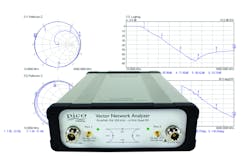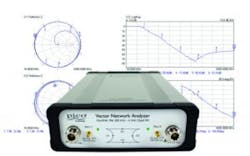Pico Technology debuts USB vector network analyzer
Pico Technology announced today that it has applied its expertise in compact USB instrumentation combined with its experience with high-performance sampling oscilloscopes and time-domain reflectometry to offer a 300-kHz to 6-GHz USB vector network analyzer.
The PicoVNA 106 USB-controlled VNA boasts a full-function, minimal-error, “Quad RX” four-receiver architecture that supports both 8- and 12-term calibration without the uncorrectable switching errors, delays, and unreliability of traditional three-receiver designs. The instrument supports convenient calibration methods such as “enhanced isolation correction” and “unknown thru,” the company reports.
The PicoVNA 106 has dynamic range of up to 118 dB at 10 Hz and 0.005-dB RMS trace noise at its maximum bandwidth of 140 kHz. It can gather all four S-parameters at just 190 μs per frequency point—in other words, a 500-point 2-port S2P Touchstone file, compatible with test, math, view, and EDA simulation tools, in less than a tenth of a second. The instrument is suitable for classrooms, small businesses, and even amateur workshops, yet it is able to meet the needs of the microwave laboratory and expert. The vendor includes bias-Ts for the convenient injection of a bias or test stimulus.
The PicoVNA 106’s small size and weight and high performance suit it to field-service, installation-test, embedded, and training applications. Its remote automation interface suits it to test automation, perhaps as a reflectometry or transmission measurement core for embedded roles. It can serve broadband-interconnect, cable-and-harnesses, antenna, component, subsystem, and assembly test applications; test environments span manufacturing to installation.
The PicoVNA 106 is supplied with Microsoft Windows software to support a range of plot formats for scalar and vector view of dual- or single-port parameters. These can be saved or exported in various graphic and tabular formats including Touchstone. The software includes, at no additional cost, inverse Fourier transformation to the time domain, adding convenient distance-to-fault capability and pulse-response determination. In all cases nominal impedance transformation (10 Ω to 200 Ω) is available, mathematically or using port matching pads, with limit tests on the Cartesian plot formats.
Unwanted measurement contributions from feed lines, probes or test jigs can be eliminated using manual or automatic reference plane offset including, when required, fully independent offset for each S-parameter. Alternatively, independent networks can be embedded or de-embedded at each port from a Touchstone representation of each, measured or synthesized. Unusually for any vector network analyzer, embedding or de-embedding is interpolated when measurement and network datasets do not share the same frequency points.
Pico also includes in its free PicoVNA 2 software two utilities to tackle gain compression (P1 dB) and AM to PM. Both of these use a port power sweep at each test frequency. Both measures are extracted using second-order interpolation.
Calibration standards and interconnect for vector network analysis can dominate both performance and costs. Pico offers PC3.5 and SMA male and female test ports via flexible and flex-formable, phase- and flatness-stable test leads. Four mating calibration standards, with traceable data, are assembled into convenient male and female SOLT housings. Like the test leads, the SMA and PC3.5 calibration standards all use robust, high-precision stainless steel connectors.
https://www.picotech.com/vector-network-analyzer/picovna-106/picovna-series?hp1
About the Author

Rick Nelson
Contributing Editor
Rick is currently Contributing Technical Editor. He was Executive Editor for EE in 2011-2018. Previously he served on several publications, including EDN and Vision Systems Design, and has received awards for signed editorials from the American Society of Business Publication Editors. He began as a design engineer at General Electric and Litton Industries and earned a BSEE degree from Penn State.

